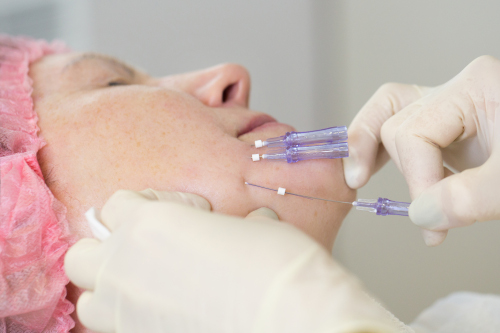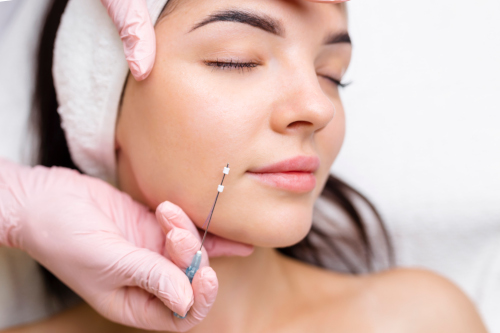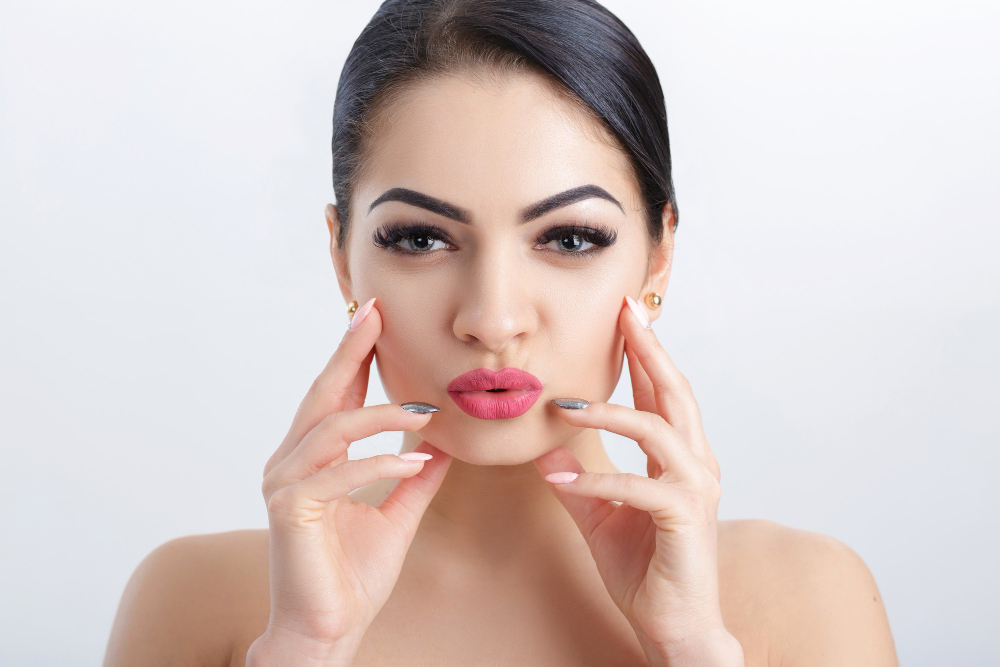PDO threads are made of polydioxanone (PDO), which is an absorbable material that has been used in surgery for many years. It has been proven to be safe in heart surgery for over 35 years.
Research has shown that PDO stimulates neocollagenesis, which encourages the production of new collagen in the skin while the body naturally absorbs the threads in several months.
The PDO thread can be used as a mesh to remove fine wrinkles or barbed thread in the lift. A lifted appearance can be seen immediately following the treatment; however, the results will improve in the following days and weeks as the PDO stimulates neocollagenesis, which in turn produces collagen. The overall texture of the skin is improved; it becomes thicker, tighter and firmer and other skin issues like open pores, fine lines and wrinkles are smoothed away as well.

Different thread lengths are employed for various facial areas. For example, short threads are used to address fine lines around the eyes, while thicker threads are suitable for enhancing the cheeks or jawline. This technique is effective for lifting drooping cheeks, a sagging jawline, and neck folds. Its popularity stems from its quick execution, typically under an hour with minimal interruptions, making it a preferred choice for those experiencing mild to moderate skin aging who aren’t ready for surgical interventions.
PDO threads are versatile and can rejuvenate almost any body part. The areas that can benefit from a PDO Thread Lift include face, neck areas, Knee, chest, buttocks and more.
A PDO lift is among the most popular nonsurgical procedures performed besides the recent new energy devices to subtly lift, tighten, and rejuvenate loose, sagging skin. The most common requests of PDO thread lift are facial rejuvenation. Thread lifts are widely considered a minimally invasive alternative to a surgical facelift. The effects from a thread lift are temporary and more subtle than those produced with a facelift. The lift can be seen at the end of the procedure and yet improvement in the appearance of fine lines, wrinkles, and skin laxity can be improved further gradually, as the procedure stimulates natural collagen production over time. The most common placements of barbed sutures for facial rejuvenation include threading in the following areas:
Smooth sutures, utilized for wrinkle improvement, can be positioned in the nasolabial fold and in areas of face and neck where enhancement of skin quality is desired.

PDO threads are made from naturally dissolving materials that require no removal. In most cases, PDO threads are entirely absorbed by the body about six months following the procedure. PDO lift results may last 18–24 months. New cog or smooth threads may be inserted to maintain the lifted, tightened appearance of the treated area.
For more information about secondary appointments following your PDO treatment, please contact us.
Before patients receive treatment, they are typically advised to avoid medications or food that might increase bleeding or bruising, such as ibuprofen, aspirin, omega-3 fatty acids, green tea, and green tea extracts.
The procedure takes about 30 minutes to 60 minutes depending on how many areas will be treated. Because of the number of threads inserted, most people will need local numbing medicine. For those who have low pain tolerance, antilytic medicine could also be used.
In general, however, clients between 35 to 55 years of age who have mild-to-moderate skin sagginess, wrinkles, and lines in the forehead, face, and/or neck are typically good candidates for this procedure. For people who have advanced wrinkles, severe tissue laxity or thinned skin other treatment may be better options. This procedure is ideal for patients who want to avoid surgical incisions, the lengthy recovery of traditional facelifts.

Thread lifts have a much lower risk of complications than cosmetic surgery procedures, including facelifts. Patients who choose a PDO thread lift have a reduced likelihood of experiencing scarring, severe bruising, and bleeding. Though rare, the following minor complications may occur.
Recovery from a thread lift is typically minimal. Patients may experience minor swelling and discomfort for the first 24–48 hours after the procedure, which can easily be managed by pain medication or cold compresses. Patients are encouraged to apply arnica for swelling and bruising. Be sure to avoid any strenuous activity for several days. Patients should avoid rubbing or stretching their face as much as possible for at least one week after the procedure to prevent accidentally dislodging the inserted threads. For 1–2 weeks following a PDO procedure, patients should avoid sleeping on your side or stomach, intense activities and exercise. Patients can return to work the next day after the procedure.
If you are interested in having the procedure done, please contact us to set up a free consultation with Dr. Yuan.
The cost of a PDO lift procedure varies depending on the specific area being treated or if multiple areas are combined for the lift. As a result, the price range can span from $700 to $3000. For a more precise quote tailored to your desired outcomes, it’s recommended to consult with Dr. Yuan. During this consultation, you can discuss the results you’re looking to achieve, which will help in determining the exact cost of your procedure.
If you’re considering alternatives to PDO lifts for facial rejuvenation, there are several other effective procedures to consider. RF microneedling, which combines radiofrequency energy with microneedling, is renowned for skin tightening and rejuvenation. Ultherapy, another popular option, employs ultrasound technology to lift and tighten skin, especially on the face and neck. For injectable treatments, Sculptra and Radiesse offer non-surgical solutions for facial contouring and reducing wrinkles. Additionally, Fractional CO2 Laser is a powerful choice for skin resurfacing, effectively addressing scars, wrinkles, and sun damage. Each of these treatments offers unique benefits and can be tailored to meet specific aesthetic goals. A consultation with a specialist can provide you with the information needed to choose the best treatment for your needs.

Copyright © 2023 Sean Yuan, MD | Cosmetic Websites by O360®
Copyright © 2021 Sean Yuan, MD | Cosmetic Websites by O360® | Privacy Policy | Terms of Use | Disclaimer | Web Accessibility Statement